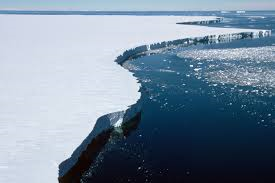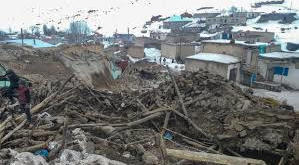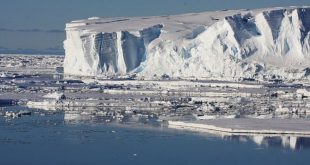Warming oceans melting Antarctic ice shelves could accelerate sea level rise
We all know intuitively that in a warmer world there will be less ice. And, since the North and South Pole regions contain lots of ice, anyone who wants to see evidence of climate change can look there.
But beyond this simplistic view, things can get pretty complex. First, it’s important to recognize that the Arctic and the Antarctic are very different places. In the Arctic, almost all the ice is floating on water – there is very little land. So, we talk about ‘sea ice’ in the north, formed from frozen sea water. On the other hand, Antarctica is a massive land mass that is covered by ice formed from snowfall (called an ‘ice sheet’). There is some floating ice around the perimeter of the land, but the vast majority of Antarctic ice is on land.
This difference not only affects how these regions response to climate change, but it also impacts their importance. We know that when floating ice melts, the ocean levels will not rise, because the ice was already floating in the water. But, when land ice melts, the liquid water flows into the ocean and causes the water levels to rise. So, at least from a sea-level perspective, land ice is more important than floating ice.
There are other differences between the north and south. One feature of the south is that there is a strong current that travels around Antarctica and partially shields it from waters elsewhere in the ocean. The Nasa Jet Propulsion Laboratory provides a good summary of some of the differences between the poles.
With global warming, both of the poles are warming quite quickly, and this warming is causing ice to melt in both regions. When we think of ice melting, we may think of it melting from above, as the ice is heated from the air, from sunlight, or from infrared energy from the atmosphere. But in truth, a lot of the melting comes from below. For instance, in the Antarctic, the ice shelves extend from the land out over the water. The bottom of the ice shelf is exposed to the ocean. If the ocean warms up, it can melt the underside of the shelf and cause it to thin or break off into the ocean.
A new study, recently published in Science Advances, looked at these issues. One of the goals of this study was to better understand whether and how the waters underneath the shelf are changing. They had to deal with the buoyancy of the waters. We know that the saltier and colder water is, the denser it is.
Around Antarctica, water at the ocean surface cools down and becomes saltier. These combined effects make the surface waters sink down to the sea floor. But as ice melt increases, fresh water flows into the ocean and interrupts this buoyancy effect. This “freshening” of the water can slow down or shut down the vertical mixing of the ocean. When this happens, the cold waters at the surface cannot sink. The deeper waters retain their heat and melt the ice from below.
The study incorporated measurements of both temperature and salinity (saltiness) at three locations near the Dalton Iceberg Tongue on the Sabrina Coast in East Antarctica. The measurements covered approximately an entire year and gave direct evidence of seasonal variations to the buoyancy of the waters. The researchers showed that a really important component to water-flow patterns were ‘polynyas.’ These are regions of open water that are surrounded by ice, typically by land ice on one side and sea ice on the other side.
A satellite photograph of a polynya is shown below. When waters from the polynya are cold and salty, the waters sink downwards and form a cold curtain around the ice shelf. However, when the waters are not salty (because fresh water is flowing into the polynya), this protective curtain is disrupted and warm waters can intrude from outside, leading to more ice melt.
Based on this study, we may see increased ice loss in the future – sort of a feedback loop. That concerns us because it will mean more sea level rise (which is already accelerating), and more damage to coastal communities. I asked the lead author, Alesandro Silvano about this work:
“We found that freshwater from melting ice shelves is already enough to stop formation of cold and salty waters in some locations around Antarctica. This process causes warming and freshening of Antarctic waters. Ocean warming increases melting of the Antarctic Ice Sheet, causing sea level to rise. Freshening of Antarctic waters weakens the currents that trap heat and carbon dioxide in the ocean, affecting the global climate. In this way local changes in Antarctica can have global implications. Multiple sources of evidence exist now to show that these changes are happening. However, what will happen in Antarctica in the next decades and centuries remains unclear and needs to be understood”.
This is just another reason to take scientists seriously and act to slow down climate change before it is too late.
The Guardian
 Lebanese Ministry of Information
Lebanese Ministry of Information



